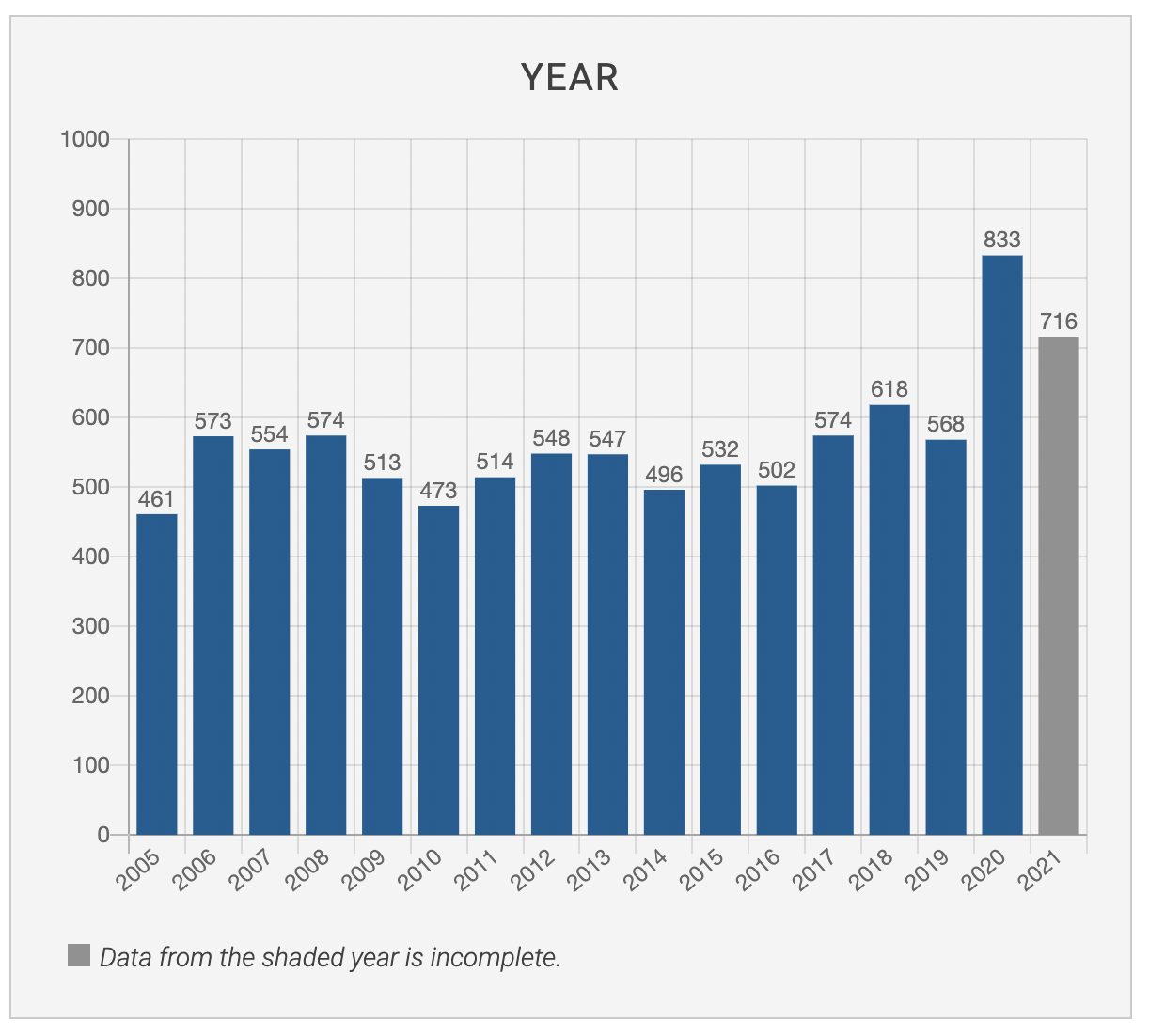Topic: incarceration
Posts related to the incarceration of individuals
Texas Jail Data: Phase 1
January 23, 2023A major focus at the Texas Justice Initiative is gathering and collecting data related to the Texas criminal justice system that is public but isn't made available in convenient or user-friendly ways. By making this data more easily accessible, we hope to provide context and insight on the Texas criminal justice system.
We’re excited to release a new series of data that relates to Texas’ jails. While what you see now looks less like “data” and more like a list of downloadable PDFs, organized by year and report type, we are making this information available in one place for the first time. This set of reports is an important first step towards building an interactive tool that will allow users to interact with the jail data in the future.
Texas jails are required to report the data in our collection to the Texas Commission on Jail Standards, which oversees the facilities. Data contained in these reports provide a glimpse of who is being incarcerated in our jails and what happens inside of them during the course of a month. Population reports total the number of individuals held in each county, and immigration detainer reports show how many of those individuals are held on federal immigration holds, and the associated costs. Another report on pregnancies shows how many individuals are pregnant in jail each month, and serious incident reports summarize the total numbers of several types of incidents that can occur in a jail every month.
Typically, the Texas Commission on Jail Standards posts many of these reports on its website, although the publication of these reports stopped “temporarily,” TCJS told us last fall. The Serious Incident Reports in our collection were only made available via TJI’s open records requests.
Collecting these reports is vital to building the interactive tool we envision, and we decided to make them available on our website, even in their original form. Our volunteers will continue to architect a system that automatically scrapes these reports, and also connects these data sets in various visuals. If you’re interested in joining our team or providing funding to help us progress, please email: eva.ruth@texasjusticeinitiative.org.
COVID-19 drives spike in deaths in Texas prisons and jails in 2020
December 22, 2021
According to custodial death data, 2020 was the deadliest year on record for people who were incarcerated in Texas prisons and jails (see graph above). At least 830 individuals died in Texas prisons and jails, an increase of 46% over the previous year (2019), based on reports filed with the Texas Office of the Attorney General. This increase was largely driven by the coronavirus, which – agencies self-reported – killed at least 278 people in prisons and jails last year.
Broken out on its own, COVID-19 was the second-highest cause of death in jails and prisons, accounting for 34% of 2020 deaths, behind all other natural causes/illnesses at 50%. Excluding COVID-19 fatalities, deaths from natural causes in 2020 were consistent with previous years. Historically, natural causes account for more than three quarters of deaths in jails and prisons. Between prisons and jails, prisons saw both the highest number of deaths overall (84%) and the highest concentration (92%) of COVID-19 deaths. Among incarcerated individuals over the age of 50, COVID-19 accounted for at least 40% of deaths.
As the COVID-19 pandemic took hold in the U.S., there was a brief acknowledgement of the unsanitary and cramped conditions – which are also a breeding ground for the novel coronavirus – characteristic of U.S. detention centers. States across the country dramatically downsized their incarcerated population and granted compassionate release to those already infected with (or more likely to die from) COVID-19. However, in Texas, explicit policies to reduce populations during the pandemic were few and far between, according to the Prison Policy Initiative.
The data on conditions in Texas facilities was often inaccurate and unreliable. The tracking dashboard maintained by the Texas Department of Criminal Justice occasionally had disclaimers stating that the data was unreliable. TDCJ also published announcements when incarcerated individuals and employees died of COVID-19, but those posts have become sporadic at best. Additionally, agencies also took longer to file their custodial death reports, some showing up months after the 30-day deadline as required by state law. Lastly, changing, incomplete or vague reporting of the precise cause of death made it difficult for watchdogs, like TJI, to capture all COVID-related deaths in their reporting. For example, during the pandemic, TJI started tracking deaths that are reportedly caused by “bronchopneumonia,” a cause that didn’t exist much on reports before 2020.
Beyond being a tragic example of the deadliness of COVID-19, the spike in deaths within Texas jails and prisons in 2020 raises questions about the conditions that make those facilities uniquely vulnerable to outbreaks. The lack of disinfectants and poor medical care, in conjunction with cramped conditions and the negative impacts of living in a high stress environment, all contribute to making jails and prisons inherently unsafe and, in 2020, increasingly deadly spaces. Worst of all, this trend doesn’t seem to be slowing down: 2021 has already exceeded 2019 totals by 6%, with 600 deaths reported as of the end of October.
NOTE: For the purposes of this analysis, custodial death reports were cross-referenced against manually-gathered reports from media and other law enforcement sources to determine whether a death was due to COVID-19. Data was pulled in the first week of November 2021.
At the Crossroads of Risk Factors
April 1, 2021In June of 2020, the executive director of the Texas Justice Initiative, Eva Ruth Moravec, started noticing a disturbing trend in the custodial death data - an alarming number of Texas Department of Criminal Justice's announcements about deaths by COVID-19 were coming from the same unit. In fact, of the 48 incarcerated individuals who died from COVID-19 in state-operated prisons and jails in June 2020, 14 were from the Duncan Unit. To put this another way: a unit that housed 0.3% of the state's prison population was suddenly reporting nearly 30% of the COVID-19 deaths that month. Together with Margarita Bronshteyn, one of TJI’s data scientists, Eva Ruth set out to understand what was driving this mortality rate and to shed light on those who died behind bars due to the pandemic, not a life sentence.
The Rufus H. Duncan Unit is a minimum-security lockup and one of Texas’ dedicated geriatric prisons. In June, the Duncan Unit housed just over 400 inmates - nearly all of whom were 55 years old or older. For many of those housed in the Duncan Unit, the intersection of incarceration and older age (often coupled with pre-existing conditions) proved to be one of many factors that put them particularly at-risk when it came to contracting and getting seriously ill from COVID-19. In just four weeks, the virus had infected 70% of the Duncan Unit's inmate population and one-third of its employees. As the summer wore on, TDCJ changed the way it reported data and TJI was unable to tell the total percentage of people who'd been infected at a particular unit.
Jeremy Desel, a TDCJ spokesman, stressed that the high positivity rate stemmed from the frequency and large scale effort when it came to testing those incarcerated in Duncan Unit. When asked about the mortality rate in particular, Desel said:
“If you look at our offender deaths — and actually, to be completely honest, our staff and offender deaths — if you look at them, across the board, there are very, very few that are not higher-risk folks, in that they have pre-existing conditions and/or are older. So you’re going to see, I think, a higher number of those instances in the older population units like Duncan.”
This past year was not the first time that the vulnerability of older, incarcerated individuals has come to light. A 2018 TDCJ employee publication reported that individuals 55 and older access in-prison health care five times more frequently than the rest of the incarcerated population. The article quoted Dr. Lannette Linthicum, director of TDCJ’s Health Services Division: “If they’re 55, they usually have the physiology of a 65-year-old, due to things such as lack of preventive health care, and behaviors such as alcohol and IV drug abuse.”
However, as people age, they also become far less likely to offend. Developed nearly four decades ago by Travis Hirschi and Michael Gottfredson, the “age-crime curve” has been a guidepost for assessing the likelihood of a returning citizen reoffending. Hirschi and Gottfreson found that, regardless of the person’ sex, criminality spikes between the ages of 12 and 25 after which there is a steep decline until reaching near-zero numbers by the age of 55. According to this model, the overwhelming majority of those incarcerated in the Duncan Unit would pose little to no risk to society upon release.
In fact, more than two-thirds of the Duncan Unit was parole eligible as of July 2020 and most of them (208 of 270) had been parole eligible for more than a year. Of the 21 men who died after contracting COVID while serving time in the Duncan Unit, 13 had served at least half their sentence, 17 were eligible for parole, and all were over the age of 60. Among these men were Jose Faide Morones, 70, who had completed his sentence but was denied parole in May of this year; and Jimmy Ray Price, 82, who’d served 24 years on a 25-year sentence and had been eligible for parole for 11 years, but was denied parole last spring.
So why were parole-eligible individuals not being released? According to Desel, additional measures, such as weeks-long precautionary lockdowns, were used to stop the spread of the virus and these lockdowns meant that everything came to a grinding halt. Movement was restricted and individuals were kept away from courses that are required for release on parole. Although TDCJ did resume the classes in late June, it has been a slow process. “[I]t’s going to be a long ordeal,” a woman who volunteers with the Texas Inmate Families Association told TJI. “A lot of these gentlemen are elderly and may not have any family left.”
Facilities in other states like New York and Illinois began releasing some of their incarcerated population in March after experiencing widespread outbreaks. In both states, the age-crime curve informed their decisions regarding whom to release. While New York prioritized releasing offenders over the age of 50 and Illinois prioritized those over 60, both states heavily weighed the presence of pre-existing conditions when reviewing cases for early-release. In both states, most releases have been the equivalent of 3rd-degree felonies or lower (see: Illinois’s IDOC spreadsheet for the full list of COVID-related releases). Researchers and reporters are no doubt watching to see if there are any spikes in crime associated with the release of offenders in either state – thus far, no publications suggest so.
